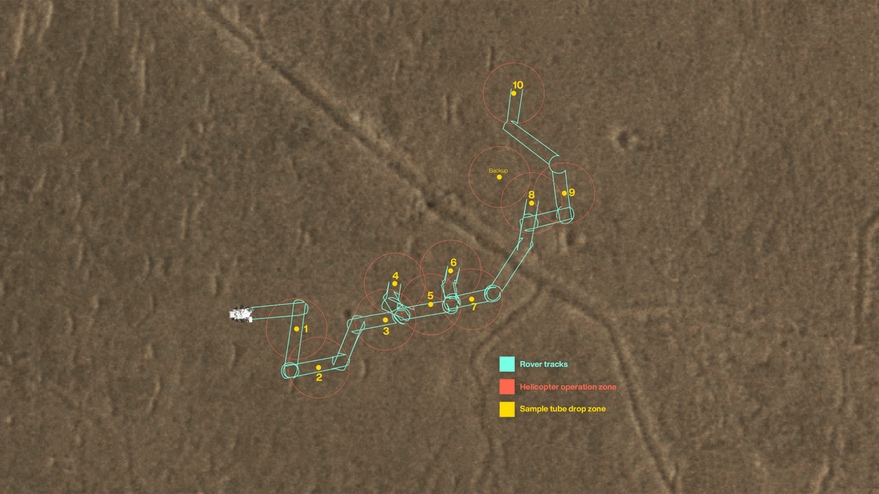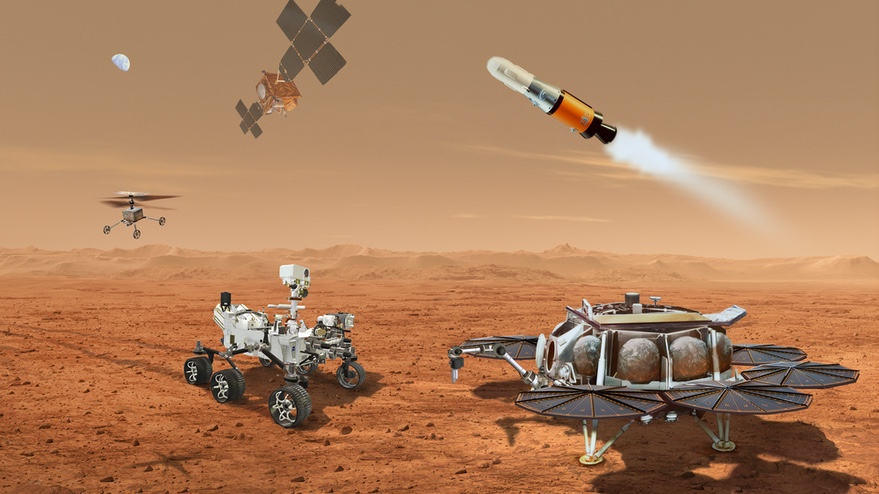WASHINGTON — NASA’s Perseverance Mars rover will soon start depositing a cache of samples that it has collected since landing last year as part of efforts to eventually return those samples to Earth.
At an online briefing Dec. 16 held during the Fall Meeting of the American Geophysical Union (AGU), project officials said the rover is scheduled to place the first of 10 sample tubes on the surface as soon as Dec. 19. Confirmation the tube was successfully placed on the surface would come in images returned the next day.
Perseverance is depositing the tubes to create a depot that could be retrieved by later missions in the overall Mars Sample Return (MSR) campaign. It will serve as a backup to Perseverance itself, which will keep other tubes and return them to a future Sample Retrieval Lander.
That lander will carry two helicopters, based on the Ingenuity helicopter included on the Perseverance missions, that will fly from the lander to the cache, picking up a tube at a time and returning them to the lander. That approach, as outlined in a revised Mars Sample Return strategy released in July, does away with a rover that would pick up samples, reducing the overall cost of the mission.
The cache is located in a region called Three Forks that will also serve as the landing site for the future Sample Retrieval Lander. “One would be hard-pressed to imagine a more benign place,” said Michael Meyer, lead scientist of the Mars Exploration Program at NASA Headquarters. The terrain is flat with few rocks or other obstructions. “The surface is like a pool table, really boring.”
The tubes will not be dropped in a single place but instead spread out over dozens of meters. “There are a lot of different requirements about how far apart the tubes can be to allow the retrieval,” said Justin Maki, Mars 2020 imaging scientist at the Jet Propulsion Laboratory. Among the biggest is placing them far enough apart that helicopters can pick them up without disturbing the rest of the cache.
The result is an intricate pattern with the 10 tubes placed between 5 and 15 meters apart from one another. Depositing them requires carrying out a “highly choreographed and strategically coordinated” plan, said Katie Stack Morgan, deputy project scientist at JPL. That process will take one to two months, she estimated.
Once the depot is complete, Perseverance will continue its science mission, heading out of the floor of Jezero Crater and onto the top of the delta created by the ancient river that flowed into the crater. The rover will continue up to the crater rim and perhaps beyond, collecting additional samples along the way.
The creation of the depot will also mark a change in sampling strategy for Perseverance. “During this prime mission, the sampling approach taken by Mars 2020 has been to collect paired samples,” said Meenakshi Wadhwa, MSR principal scientist at Arizona State University. One tube of each pair will be placed in the cache and the other retained on the rover.
After completing the cache, Perseverance will switch to a “single sample strategy,” said Stack Morgan, collecting only one sample at a time. “We can think about more locations and more kinds of rocks we can sample.” Perseverance has filled 21 of its 43 tubes so far.

Helicopter development
As Perseverance deposits sample tubes as the depot, engineers are working on the design of the helicopters that would pick them up.
That effort started in earnest about six months ago, when MSR managers asked the Ingenuity team if a helicopter based on that design could be used to pick up sample tubes, said Teddy Tzanetos, manager for Sample Recovery Helicopter at JPL, during another AGU Fall Meeting briefing Dec. 12. There had been some earlier studies, he said, looking at the feasibility of using an Ingenuity-based helicopter for transporting sample tubes.
The new helicopter is similar to Ingenuity, with the biggest differences being the addition of a robotic arm to pick up sample tubes and wheels on each of its four landing legs. It weighs 2.3 kilograms, about half a kilogram more than Ingenuity, and can carry a 150-gram sample tube. Other characteristics, including its maximum speed, range and flight time, are the same as Ingenuity.
“We want to, where we can, rely on heritage, and where appropriate, deviate from that heritage to generate this new capability,” he said. “But we are largely leveraging all of the amazing lessons learned that we have learned, and will continue to learn, from Ingenuity over the last year and a half.”
Retrieving a sample will take four sols, or Martian days. On the first sol, the helicopter will fly from the Sample Retrieval Lander to a landing site a few meters from the tube. On the second sol, the helicopter will roll up to the tube and grapple it. On the third sol, the helicopter will fly back to the lander, and on the fourth sol roll into position so that the lander’s robotic arm can take the tube.
“We’re really a fusion now of a small little rover that can fly, or you can think about it as a small helicopter that can drive,” Tzanetos said.
He said the new helicopter can leverage the design in Ingenuity because of conservative margins in the design of Ingenuity, so that the new one can be heavier without any major changes. “We’re going to keep testing that to see how much further we can push our old heritage design. We’re going to be making some decisions in the months ahead of us about how much of our heritage that we want to keep versus how much do we want to change.”
Ingenuity, meanwhile, continues to operate on Mars, far exceeding original plans for no more than five flights. At the Dec. 12 AGU briefing, Håvard Grip, chief pilot for Ingenuity, noted that before the first flight the project created a logbook for recording the flights. “A book with only five pages is going to look too silly, so we put a bunch of extra pages in here, just so it would look like a real book.”
Ingenuity made its 36th flight Dec. 10, traveling 110 meters in one minute. “Guess what?” Grip said. “We are out of pages.”
